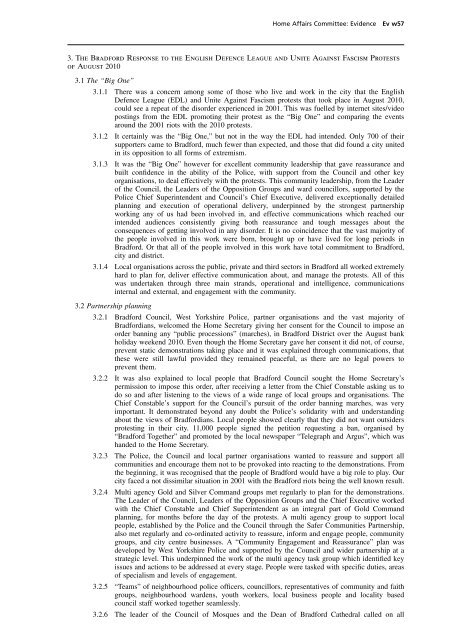Policing Large Scale Disorder: Lessons from the disturbances of ...
Policing Large Scale Disorder: Lessons from the disturbances of ...
Policing Large Scale Disorder: Lessons from the disturbances of ...
Create successful ePaper yourself
Turn your PDF publications into a flip-book with our unique Google optimized e-Paper software.
Home Affairs Committee: Evidence Ev w57<br />
3. The Bradford Response to <strong>the</strong> English Defence League and Unite Against Fascism Protests<br />
<strong>of</strong> August 2010<br />
3.1 The “Big One”<br />
3.1.1 There was a concern among some <strong>of</strong> those who live and work in <strong>the</strong> city that <strong>the</strong> English<br />
Defence League (EDL) and Unite Against Fascism protests that took place in August 2010,<br />
could see a repeat <strong>of</strong> <strong>the</strong> disorder experienced in 2001. This was fuelled by internet sites/video<br />
postings <strong>from</strong> <strong>the</strong> EDL promoting <strong>the</strong>ir protest as <strong>the</strong> “Big One” and comparing <strong>the</strong> events<br />
around <strong>the</strong> 2001 riots with <strong>the</strong> 2010 protests.<br />
3.1.2 It certainly was <strong>the</strong> “Big One,” but not in <strong>the</strong> way <strong>the</strong> EDL had intended. Only 700 <strong>of</strong> <strong>the</strong>ir<br />
supporters came to Bradford, much fewer than expected, and those that did found a city united<br />
in its opposition to all forms <strong>of</strong> extremism.<br />
3.1.3 It was <strong>the</strong> “Big One” however for excellent community leadership that gave reassurance and<br />
built confidence in <strong>the</strong> ability <strong>of</strong> <strong>the</strong> Police, with support <strong>from</strong> <strong>the</strong> Council and o<strong>the</strong>r key<br />
organisations, to deal effectively with <strong>the</strong> protests. This community leadership, <strong>from</strong> <strong>the</strong> Leader<br />
<strong>of</strong> <strong>the</strong> Council, <strong>the</strong> Leaders <strong>of</strong> <strong>the</strong> Opposition Groups and ward councillors, supported by <strong>the</strong><br />
Police Chief Superintendent and Council’s Chief Executive, delivered exceptionally detailed<br />
planning and execution <strong>of</strong> operational delivery, underpinned by <strong>the</strong> strongest partnership<br />
working any <strong>of</strong> us had been involved in, and effective communications which reached our<br />
intended audiences consistently giving both reassurance and tough messages about <strong>the</strong><br />
consequences <strong>of</strong> getting involved in any disorder. It is no coincidence that <strong>the</strong> vast majority <strong>of</strong><br />
<strong>the</strong> people involved in this work were born, brought up or have lived for long periods in<br />
Bradford. Or that all <strong>of</strong> <strong>the</strong> people involved in this work have total commitment to Bradford,<br />
city and district.<br />
3.1.4 Local organisations across <strong>the</strong> public, private and third sectors in Bradford all worked extremely<br />
hard to plan for, deliver effective communication about, and manage <strong>the</strong> protests. All <strong>of</strong> this<br />
was undertaken through three main strands, operational and intelligence, communications<br />
internal and external, and engagement with <strong>the</strong> community.<br />
3.2 Partnership planning<br />
3.2.1 Bradford Council, West Yorkshire Police, partner organisations and <strong>the</strong> vast majority <strong>of</strong><br />
Bradfordians, welcomed <strong>the</strong> Home Secretary giving her consent for <strong>the</strong> Council to impose an<br />
order banning any “public processions” (marches), in Bradford District over <strong>the</strong> August bank<br />
holiday weekend 2010. Even though <strong>the</strong> Home Secretary gave her consent it did not, <strong>of</strong> course,<br />
prevent static demonstrations taking place and it was explained through communications, that<br />
<strong>the</strong>se were still lawful provided <strong>the</strong>y remained peaceful, as <strong>the</strong>re are no legal powers to<br />
prevent <strong>the</strong>m.<br />
3.2.2 It was also explained to local people that Bradford Council sought <strong>the</strong> Home Secretary’s<br />
permission to impose this order, after receiving a letter <strong>from</strong> <strong>the</strong> Chief Constable asking us to<br />
do so and after listening to <strong>the</strong> views <strong>of</strong> a wide range <strong>of</strong> local groups and organisations. The<br />
Chief Constable’s support for <strong>the</strong> Council’s pursuit <strong>of</strong> <strong>the</strong> order banning marches, was very<br />
important. It demonstrated beyond any doubt <strong>the</strong> Police’s solidarity with and understanding<br />
about <strong>the</strong> views <strong>of</strong> Bradfordians. Local people showed clearly that <strong>the</strong>y did not want outsiders<br />
protesting in <strong>the</strong>ir city. 11,000 people signed <strong>the</strong> petition requesting a ban, organised by<br />
“Bradford Toge<strong>the</strong>r” and promoted by <strong>the</strong> local newspaper “Telegraph and Argus”, which was<br />
handed to <strong>the</strong> Home Secretary.<br />
3.2.3 The Police, <strong>the</strong> Council and local partner organisations wanted to reassure and support all<br />
communities and encourage <strong>the</strong>m not to be provoked into reacting to <strong>the</strong> demonstrations. From<br />
<strong>the</strong> beginning, it was recognised that <strong>the</strong> people <strong>of</strong> Bradford would have a big role to play. Our<br />
city faced a not dissimilar situation in 2001 with <strong>the</strong> Bradford riots being <strong>the</strong> well known result.<br />
3.2.4 Multi agency Gold and Silver Command groups met regularly to plan for <strong>the</strong> demonstrations.<br />
The Leader <strong>of</strong> <strong>the</strong> Council, Leaders <strong>of</strong> <strong>the</strong> Opposition Groups and <strong>the</strong> Chief Executive worked<br />
with <strong>the</strong> Chief Constable and Chief Superintendent as an integral part <strong>of</strong> Gold Command<br />
planning, for months before <strong>the</strong> day <strong>of</strong> <strong>the</strong> protests. A multi agency group to support local<br />
people, established by <strong>the</strong> Police and <strong>the</strong> Council through <strong>the</strong> Safer Communities Partnership,<br />
also met regularly and co-ordinated activity to reassure, inform and engage people, community<br />
groups, and city centre businesses. A “Community Engagement and Reassurance” plan was<br />
developed by West Yorkshire Police and supported by <strong>the</strong> Council and wider partnership at a<br />
strategic level. This underpinned <strong>the</strong> work <strong>of</strong> <strong>the</strong> multi agency task group which identified key<br />
issues and actions to be addressed at every stage. People were tasked with specific duties, areas<br />
<strong>of</strong> specialism and levels <strong>of</strong> engagement.<br />
3.2.5 “Teams” <strong>of</strong> neighbourhood police <strong>of</strong>ficers, councillors, representatives <strong>of</strong> community and faith<br />
groups, neighbourhood wardens, youth workers, local business people and locality based<br />
council staff worked toge<strong>the</strong>r seamlessly.<br />
3.2.6 The leader <strong>of</strong> <strong>the</strong> Council <strong>of</strong> Mosques and <strong>the</strong> Dean <strong>of</strong> Bradford Ca<strong>the</strong>dral called on all
















